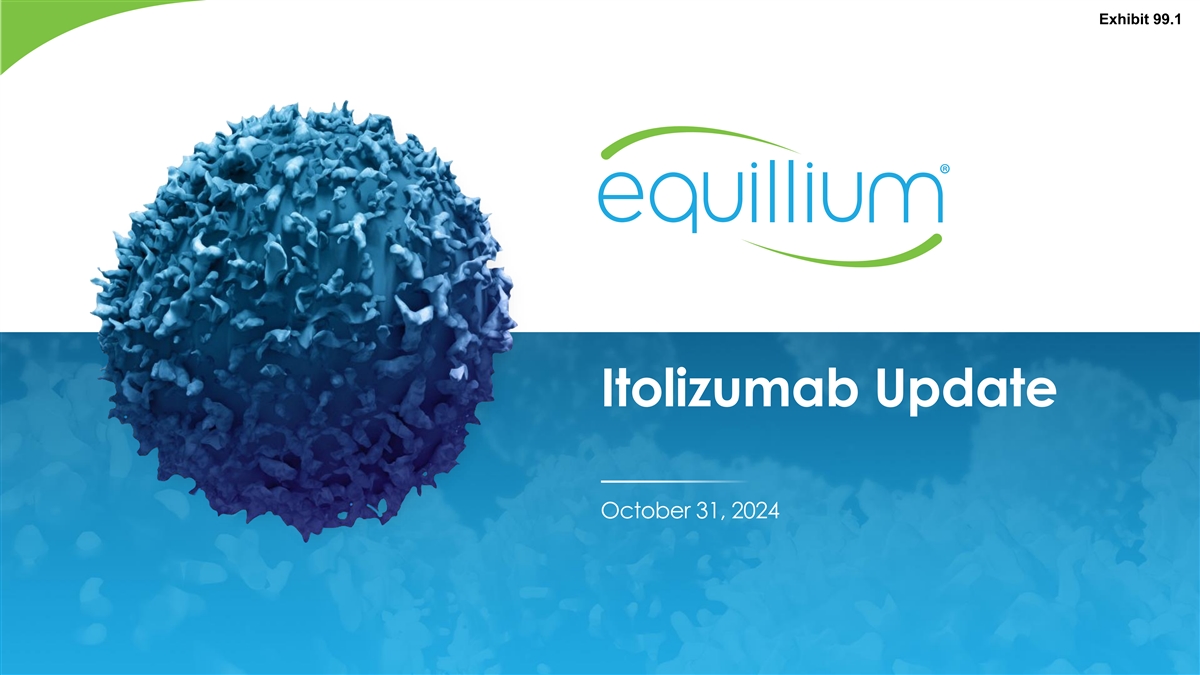
Exhibit 99.1 Itolizumab Update October 31, 2024
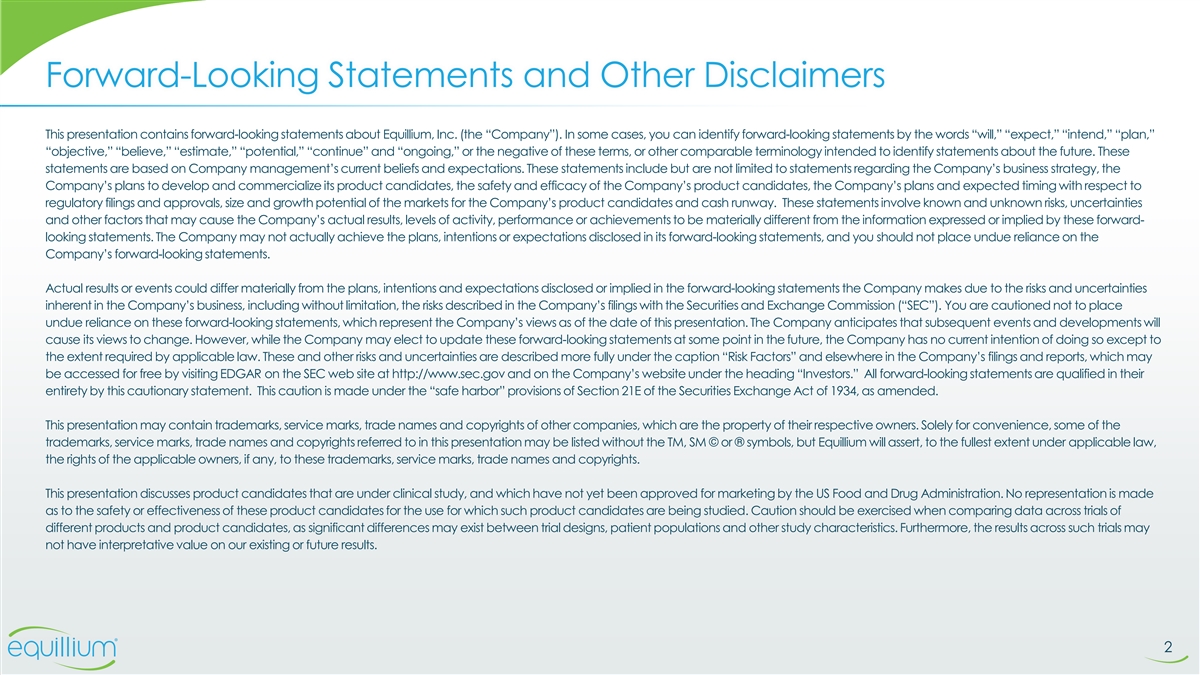
Forward-Looking Statements and Other Disclaimers This presentation contains forward-looking statements about Equillium, Inc. (the “Company”). In some cases, you can identify forward-looking statements by the words “will,” “expect,” “intend,” “plan,” “objective,” “believe,” “estimate,” “potential,” “continue” and “ongoing,” or the negative of these terms, or other comparable terminology intended to identify statements about the future. These statements are based on Company management’s current beliefs and expectations. These statements include but are not limited to statements regarding the Company’s business strategy, the Company’s plans to develop and commercialize its product candidates, the safety and efficacy of the Company’s product candidates, the Company’s plans and expected timing with respect to regulatory filings and approvals, size and growth potential of the markets for the Company’s product candidates and cash runway. These statements involve known and unknown risks, uncertainties and other factors that may cause the Company’s actual results, levels of activity, performance or achievements to be materially different from the information expressed or implied by these forward- looking statements. The Company may not actually achieve the plans, intentions or expectations disclosed in its forward-looking statements, and you should not place undue reliance on the Company’s forward-looking statements. Actual results or events could differ materially from the plans, intentions and expectations disclosed or implied in the forward-looking statements the Company makes due to the risks and uncertainties inherent in the Company’s business, including without limitation, the risks described in the Company’s filings with the Securities and Exchange Commission (“SEC”). You are cautioned not to place undue reliance on these forward-looking statements, which represent the Company’s views as of the date of this presentation. The Company anticipates that subsequent events and developments will cause its views to change. However, while the Company may elect to update these forward-looking statements at some point in the future, the Company has no current intention of doing so except to the extent required by applicable law. These and other risks and uncertainties are described more fully under the caption “Risk Factors” and elsewhere in the Company’s filings and reports, which may be accessed for free by visiting EDGAR on the SEC web site at http://www.sec.gov and on the Company’s website under the heading “Investors.” All forward-looking statements are qualified in their entirety by this cautionary statement. This caution is made under the “safe harbor” provisions of Section 21E of the Securities Exchange Act of 1934, as amended. This presentation may contain trademarks, service marks, trade names and copyrights of other companies, which are the property of their respective owners. Solely for convenience, some of the trademarks, service marks, trade names and copyrights referred to in this presentation may be listed without the TM, SM © or ® symbols, but Equillium will assert, to the fullest extent under applicable law, the rights of the applicable owners, if any, to these trademarks, service marks, trade names and copyrights. This presentation discusses product candidates that are under clinical study, and which have not yet been approved for marketing by the US Food and Drug Administration. No representation is made as to the safety or effectiveness of these product candidates for the use for which such product candidates are being studied. Caution should be exercised when comparing data across trials of different products and product candidates, as significant differences may exist between trial designs, patient populations and other study characteristics. Furthermore, the results across such trials may not have interpretative value on our existing or future results. 2
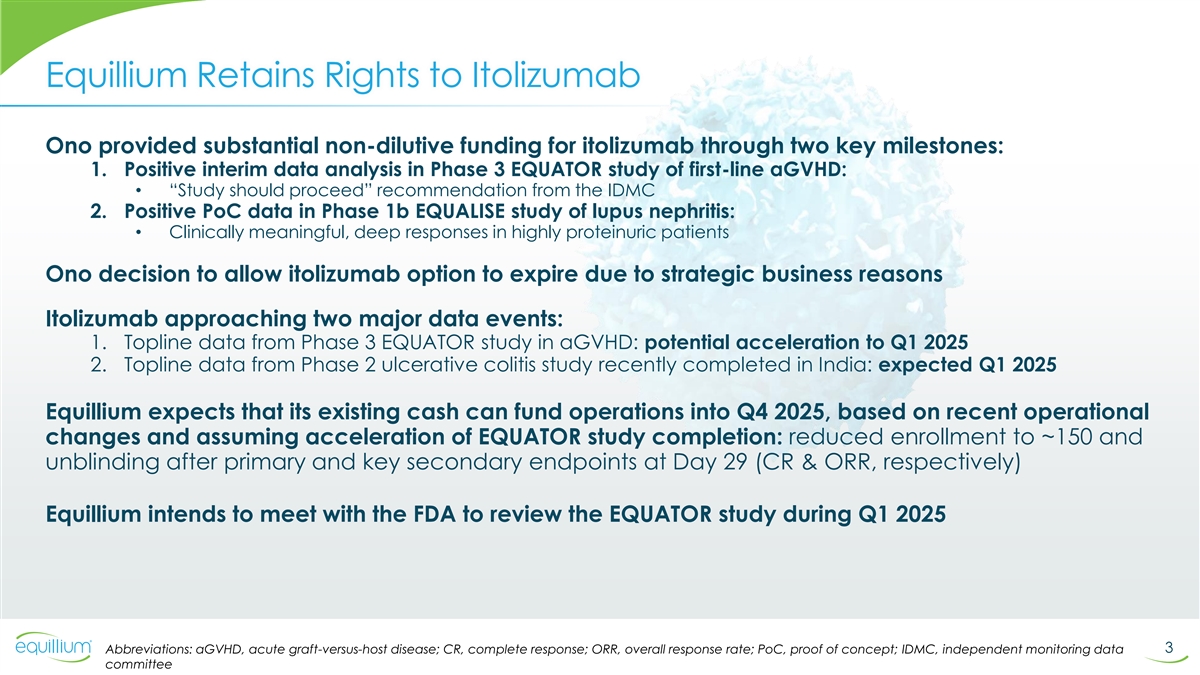
Equillium Retains Rights to Itolizumab Ono provided substantial non-dilutive funding for itolizumab through two key milestones: 1. Positive interim data analysis in Phase 3 EQUATOR study of first-line aGVHD: • “Study should proceed” recommendation from the IDMC 2. Positive PoC data in Phase 1b EQUALISE study of lupus nephritis: • Clinically meaningful, deep responses in highly proteinuric patients Ono decision to allow itolizumab option to expire due to strategic business reasons Itolizumab approaching two major data events: 1. Topline data from Phase 3 EQUATOR study in aGVHD: potential acceleration to Q1 2025 2. Topline data from Phase 2 ulcerative colitis study recently completed in India: expected Q1 2025 Equillium expects that its existing cash can fund operations into Q4 2025, based on recent operational changes and assuming acceleration of EQUATOR study completion: reduced enrollment to ~150 and unblinding after primary and key secondary endpoints at Day 29 (CR & ORR, respectively) Equillium intends to meet with the FDA to review the EQUATOR study during Q1 2025 3 Abbreviations: aGVHD, acute graft-versus-host disease; CR, complete response; ORR, overall response rate; PoC, proof of concept; IDMC, independent monitoring data committee
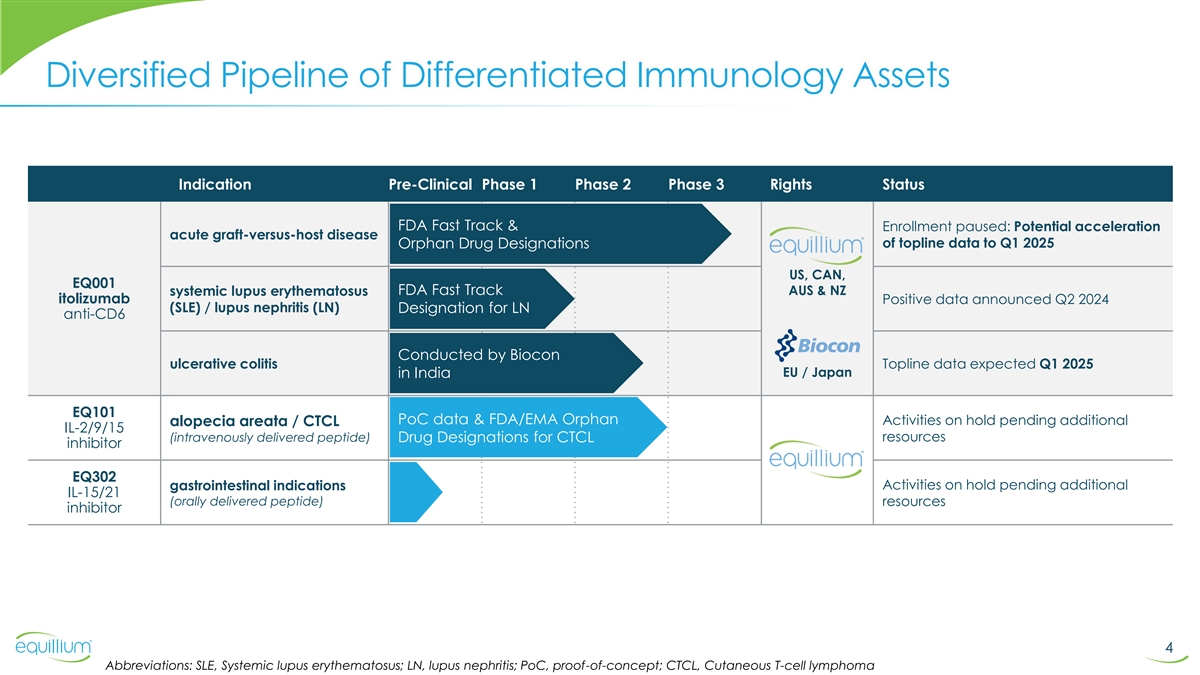
Diversified Pipeline of Differentiated Immunology Assets Indication Pre-Clinical Phase 1 Phase 2 Phase 3 Rights Status FDA Fast Track & Enrollment paused: Potential acceleration acute graft-versus-host disease of topline data to Q1 2025 Orphan Drug Designations US, CAN, EQ001 FDA Fast Track AUS & NZ systemic lupus erythematosus itolizumab Positive data announced Q2 2024 (SLE) / lupus nephritis (LN) Designation for LN anti-CD6 Conducted by Biocon ulcerative colitis Topline data expected Q1 2025 in India EU / Japan EQ101 PoC data & FDA/EMA Orphan Activities on hold pending additional alopecia areata / CTCL IL-2/9/15 resources (intravenously delivered peptide) Drug Designations for CTCL inhibitor EQ302 gastrointestinal indications Activities on hold pending additional IL-15/21 (orally delivered peptide) resources inhibitor 4 Abbreviations: SLE, Systemic lupus erythematosus; LN, lupus nephritis; PoC, proof-of-concept; CTCL, Cutaneous T-cell lymphoma
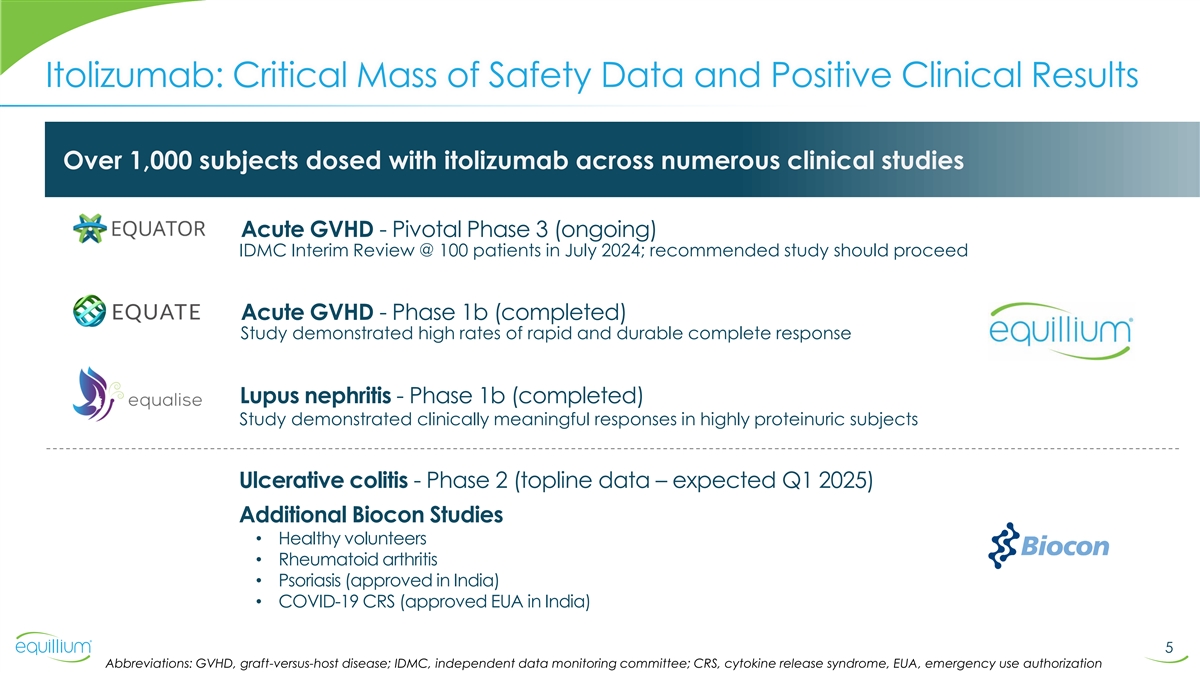
Itolizumab: Critical Mass of Safety Data and Positive Clinical Results Over 1,000 subjects dosed with itolizumab across numerous clinical studies Acute GVHD - Pivotal Phase 3 (ongoing) IDMC Interim Review @ 100 patients in July 2024; recommended study should proceed Acute GVHD - Phase 1b (completed) Study demonstrated high rates of rapid and durable complete response Lupus nephritis - Phase 1b (completed) Study demonstrated clinically meaningful responses in highly proteinuric subjects Ulcerative colitis - Phase 2 (topline data – expected Q1 2025) Additional Biocon Studies • Healthy volunteers • Rheumatoid arthritis • Psoriasis (approved in India) • COVID-19 CRS (approved EUA in India) 5 Abbreviations: GVHD, graft-versus-host disease; IDMC, independent data monitoring committee; CRS, cytokine release syndrome, EUA, emergency use authorization
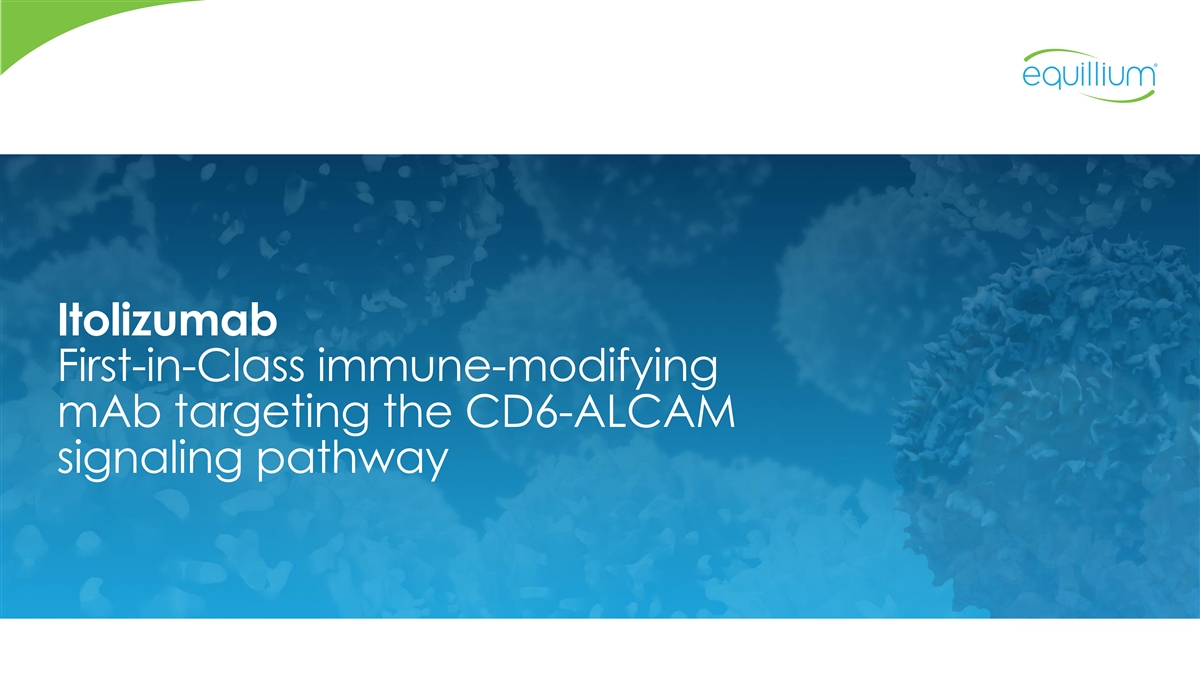
Itolizumab First-in-Class immune-modifying mAb targeting the CD6-ALCAM signaling pathway
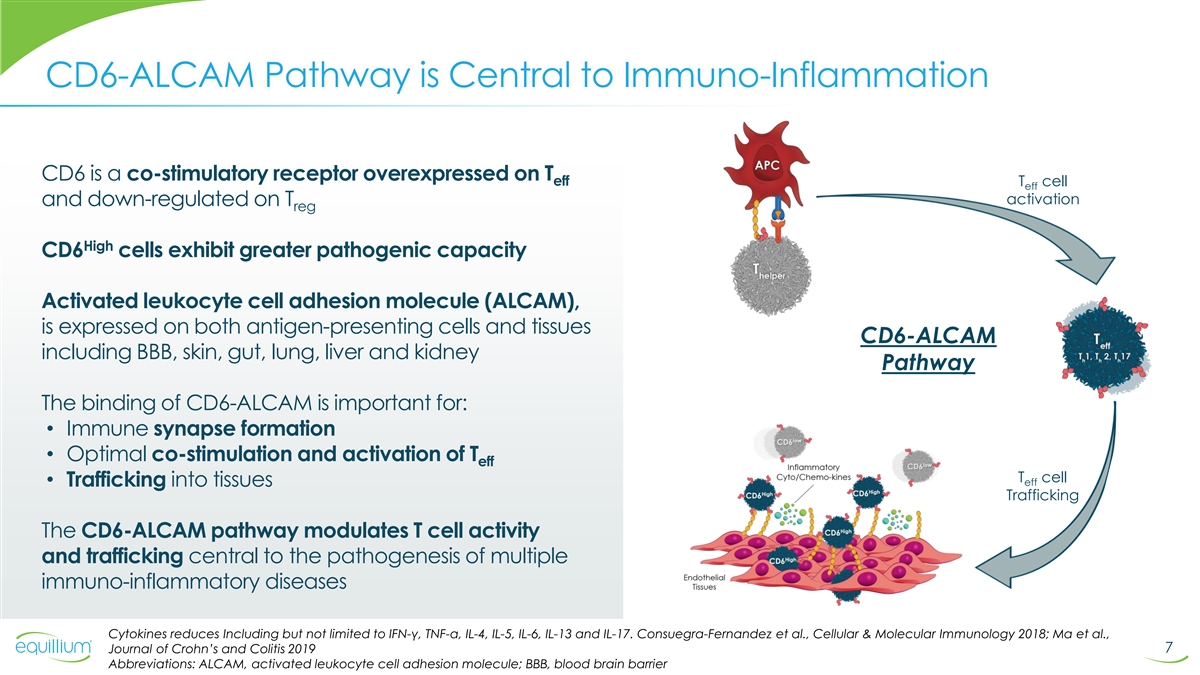
CD6-ALCAM Pathway is Central to Immuno-Inflammation CD6 is a co-stimulatory receptor overexpressed on T eff T cell eff activation and down-regulated on T reg High CD6 cells exhibit greater pathogenic capacity Activated leukocyte cell adhesion molecule (ALCAM), is expressed on both antigen-presenting cells and tissues CD6-ALCAM including BBB, skin, gut, lung, liver and kidney Pathway The binding of CD6-ALCAM is important for: • Immune synapse formation • Optimal co-stimulation and activation of T eff T cell • Trafficking into tissues eff Trafficking The CD6-ALCAM pathway modulates T cell activity and trafficking central to the pathogenesis of multiple immuno-inflammatory diseases Cytokines reduces Including but not limited to IFN-γ, TNF-α, IL-4, IL-5, IL-6, IL-13 and IL-17. Consuegra-Fernandez et al., Cellular & Molecular Immunology 2018; Ma et al., 7 Journal of Crohn’s and Colitis 2019 Abbreviations: ALCAM, activated leukocyte cell adhesion molecule; BBB, blood brain barrier
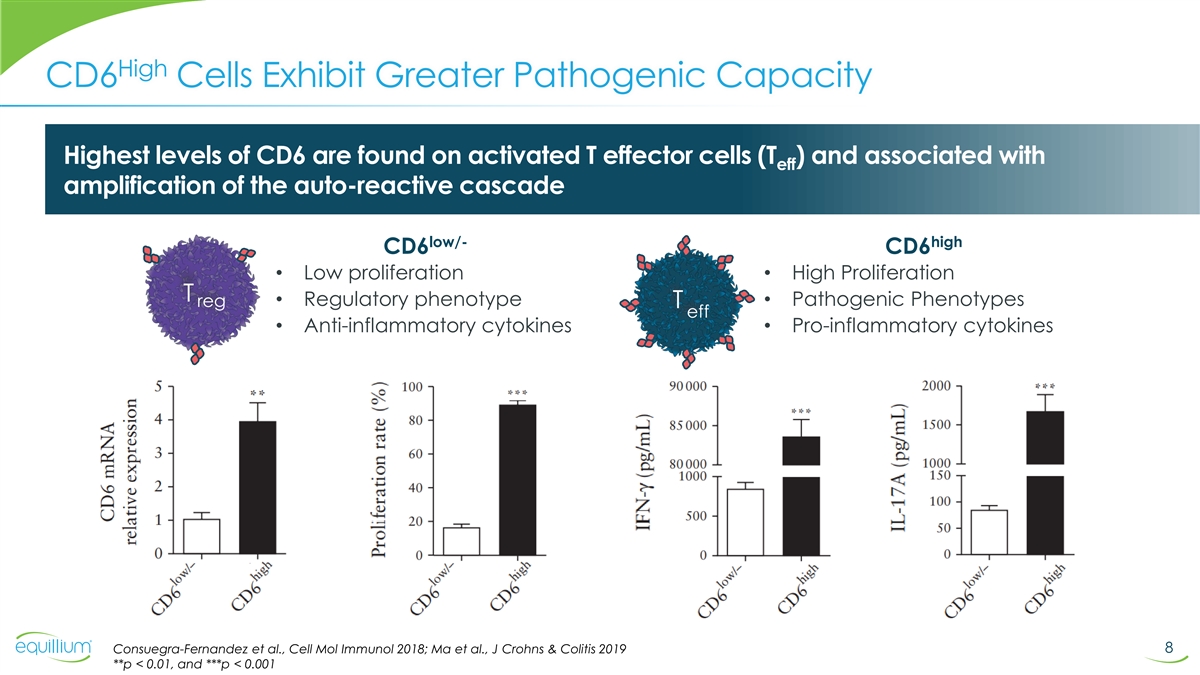
High CD6 Cells Exhibit Greater Pathogenic Capacity Highest levels of CD6 are found on activated T effector cells (T ) and associated with eff amplification of the auto-reactive cascade low/- high CD6 CD6 • Low proliferation• High Proliferation T • Regulatory phenotype• Pathogenic Phenotypes reg T eff • Anti-inflammatory cytokines• Pro-inflammatory cytokines 8 Consuegra-Fernandez et al., Cell Mol Immunol 2018; Ma et al., J Crohns & Colitis 2019 **p < 0.01, and ***p < 0.001

Itolizumab-induced Loss of Cell Surface CD6 Inhibits T Cells eff Itolizumab leads to loss of CD6 in both a dose and time-dependent † manner resulting in T cells that are hyporesponsive to TCR stimulation Pathogenic hi CD6✱✱✱ ✱✱ T Cells 20000 500000 eff 1.2 400000 15000 0.9 1* 300000 10* 10000 0.6 Itolizumab 200000 Antigenic 0.3 5000 Modulation 100000 (shedding) 0.0 0 0 1 10 100 1000 10000 high isotype Tx 10µg/ml (CD6 ) Incubation Time (Minutes) low itolizumab Tx 10µg/ml (CD6 ) ^ low • Itolizumab binds to domain-1 of CD6 causing dose-dependent loss of CD6 Non-pathogenic CD6 T Cells eff • Itolizumab-induced loss of CD6 results in hyporesponsive T cells ^ • Loss of CD6 is a pharmacodynamic marker that can be monitored in patients † Chu, D., Ampudia, J., Connelly, S., & Ng, C. (2021). American Association of Immunologists 104th annual meeting. See Equillium website for details. *clinically relevant doses, **p<0.01, ***p<0.001 ^ 9 detected with a non-competing anti-CD6 antibody Abbreviations: TCR, T-cell receptor Surface CD6 Expression (MFI normalized to Isotype) CD25 MFI IL-2 MFI
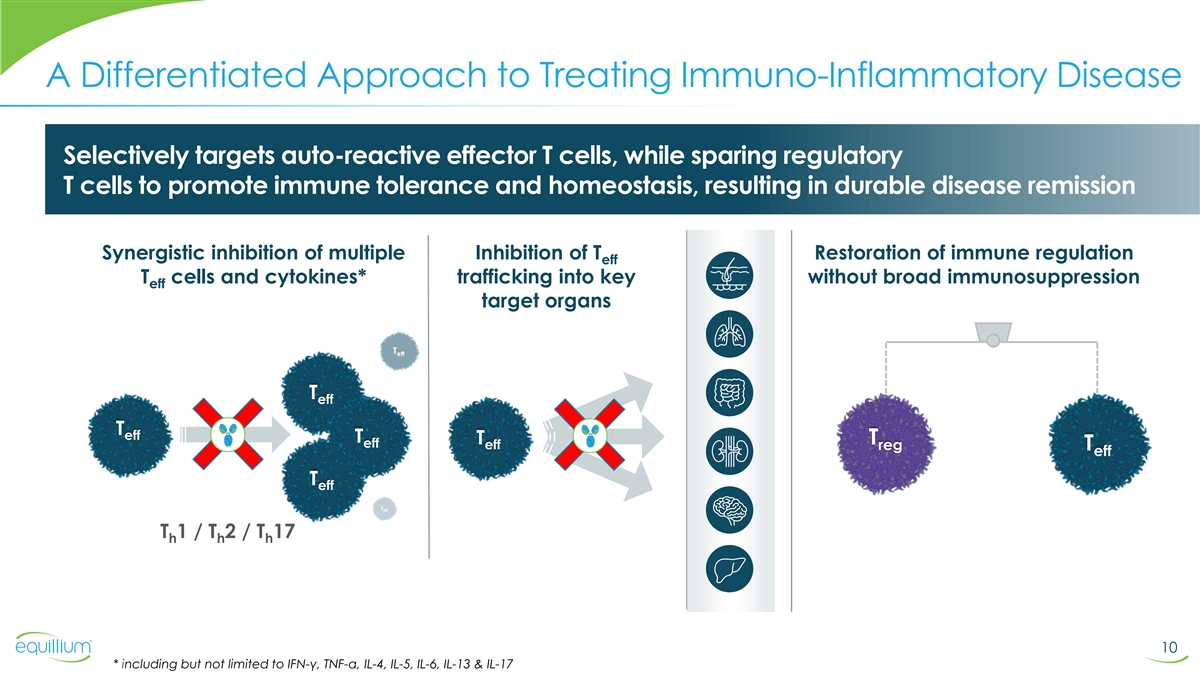
A Differentiated Approach to Treating Immuno-Inflammatory Disease Selectively targets auto-reactive effector T cells, while sparing regulatory T cells to promote immune tolerance and homeostasis, resulting in durable disease remission Synergistic inhibition of multiple Inhibition of T Restoration of immune regulation eff T cells and cytokines* trafficking into key without broad immunosuppression eff target organs T eff T eff T T T eff eff reg T eff T eff T 1 / T 2 / T 17 h h h 10 * including but not limited to IFN-γ, TNF-α, IL-4, IL-5, IL-6, IL-13 & IL-17
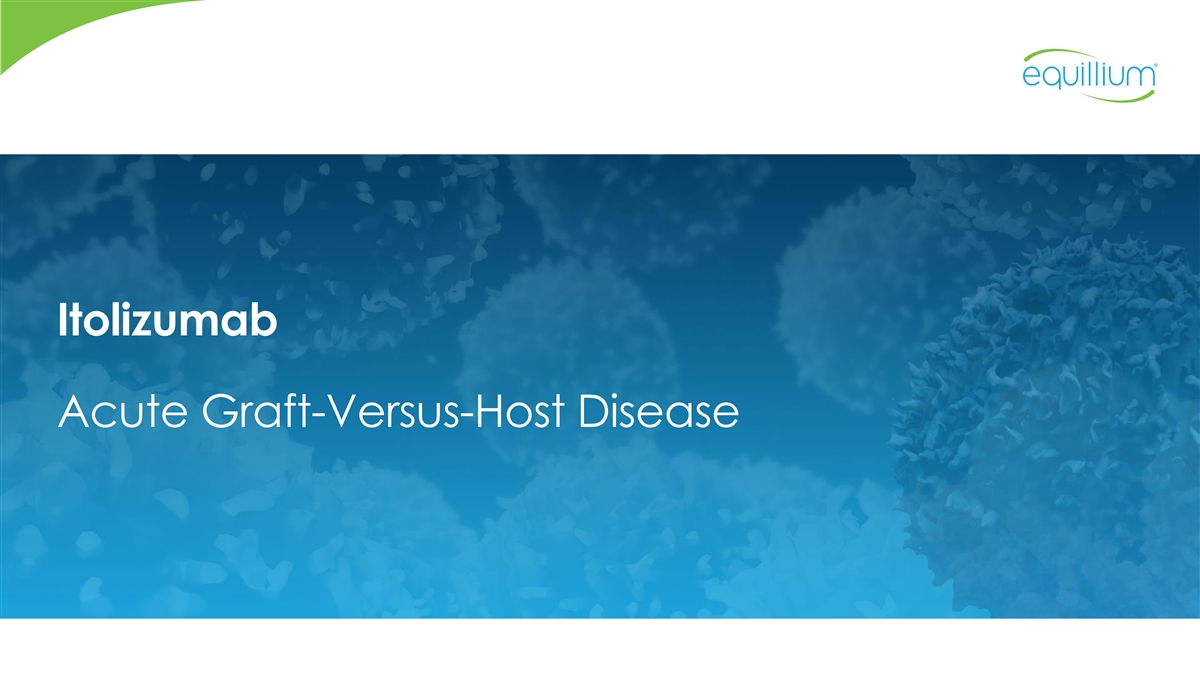
Itolizumab Acute Graft-Versus-Host Disease

Itolizumab in GVHD: Executive Summary • Positive topline data from Phase 1b EQUATE study in acute graft-versus-host disease • Achieved CR and ORR at Day 29 of 61% and 67%, respectively* • Response at Day 29 was associated with improved progression-free survival through 1 year • Responders were able to taper steroids by 70% at Day 29 and 99% at Day 169 • Itolizumab continued to demonstrate favorable safety, tolerability and efficacy profile • Positive data from Phase 3 EQUATOR study is expected to support registration • Currently no drugs approved for first-line aGVHD • Commercial scale manufacturing in place (Biocon) • Significant market: 2021 JAMA Oncology study estimated ~10,000 patients receive allo-HSCT annually • ~ 20-40% of HSCT patients develop acute GVHD** • ~ 40-50% develop chronic GVHD** • Approved therapies in 2L aGVHD & 2L cGVHD approaching $1 billion in revenue • Attractive commercial opportunity: ability to launch independently with small commercial team • Opportunities for rapid indication expansion through single Phase 3 studies * All subjects dosed within 72 hours of corticosteroid administration 12 ** 2022 Dana-Farber Report Abbreviations: CR, complete response rate; ORR, overall response rate; GVHD, graft-versus-host disease; HSCT, hematopoietic stem cell transplant
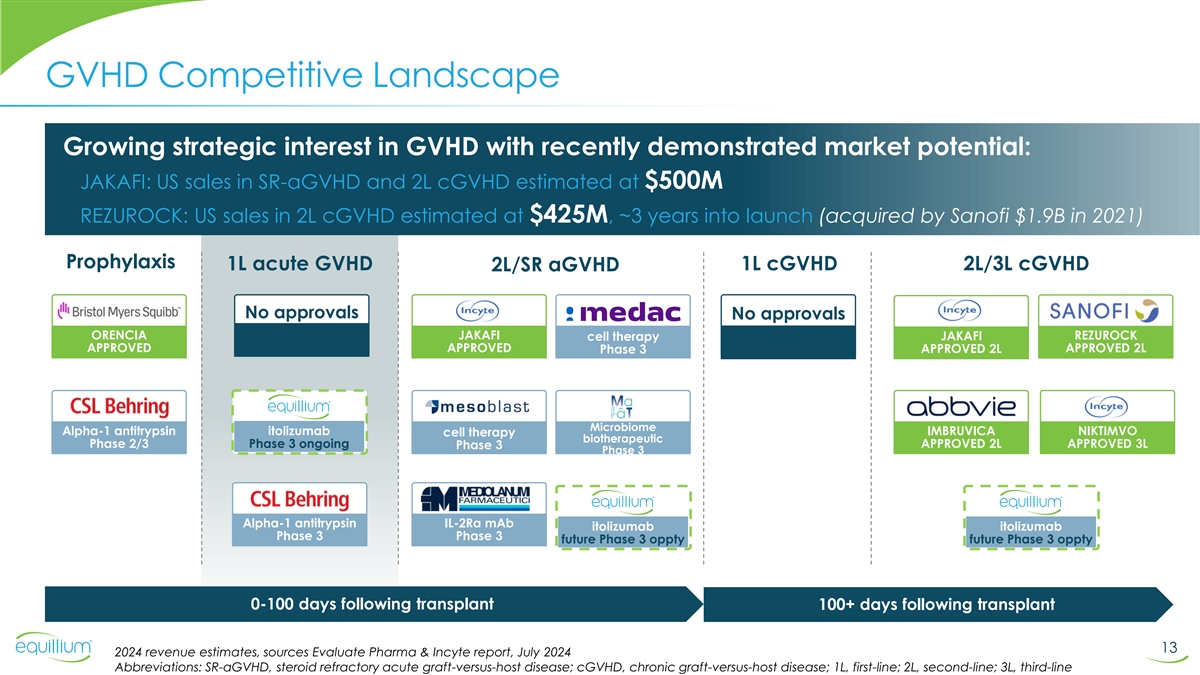
GVHD Competitive Landscape Growing strategic interest in GVHD with recently demonstrated market potential: JAKAFI: US sales in SR-aGVHD and 2L cGVHD estimated at $500M REZUROCK: US sales in 2L cGVHD estimated at $425M, ~3 years into launch (acquired by Sanofi $1.9B in 2021) Prophylaxis 1L acute GVHD 1L cGVHD 2L/3L cGVHD 2L/SR aGVHD No approvals No approvals ORENCIA JAKAFI JAKAFI REZUROCK cell therapy APPROVED APPROVED APPROVED 2L Phase 3 APPROVED 2L Microbiome Alpha-1 antitrypsin itolizumab IMBRUVICA NIKTIMVO cell therapy biotherapeutic Phase 2/3 Phase 3 ongoing APPROVED 2L APPROVED 3L Phase 3 Phase 3 Alpha-1 antitrypsin IL-2Ra mAb itolizumab itolizumab Phase 3 Phase 3 future Phase 3 oppty future Phase 3 oppty 0-100 days following transplant 100+ days following transplant 13 2024 revenue estimates, sources Evaluate Pharma & Incyte report, July 2024 Abbreviations: SR-aGVHD, steroid refractory acute graft-versus-host disease; cGVHD, chronic graft-versus-host disease; 1L, first-line; 2L, second-line; 3L, third-line
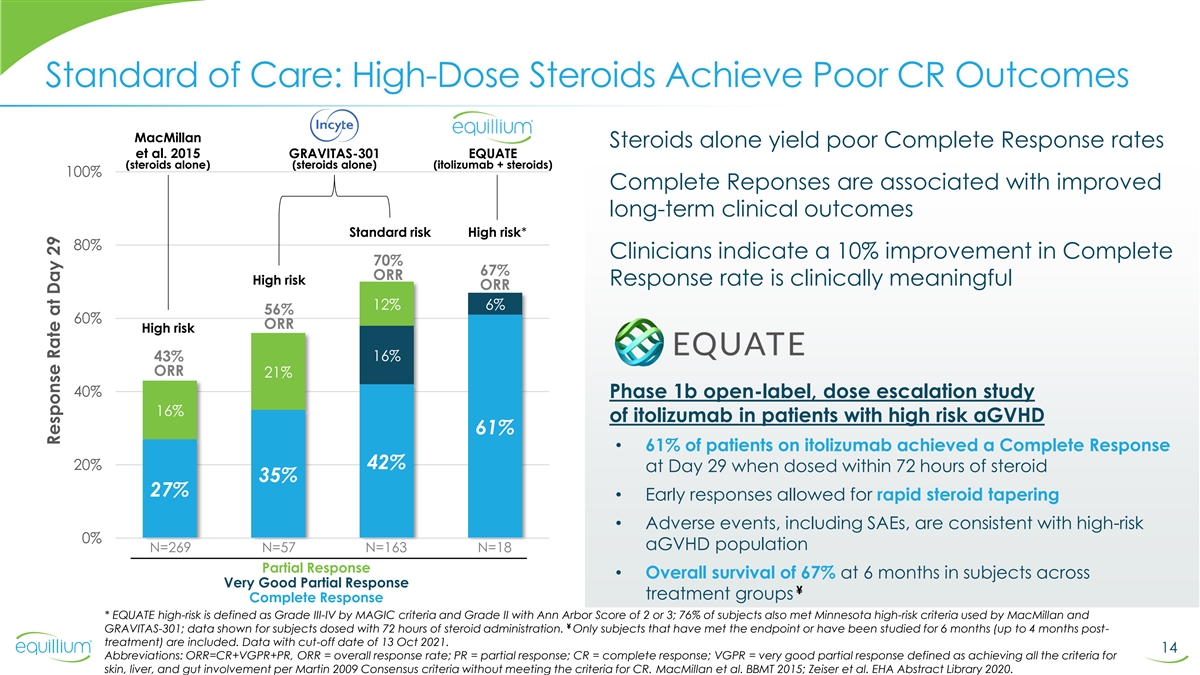
Standard of Care: High-Dose Steroids Achieve Poor CR Outcomes MacMillan Steroids alone yield poor Complete Response rates et al. 2015 GRAVITAS-301 EQUATE (steroids alone) (steroids alone) (itolizumab + steroids) 100% Complete Reponses are associated with improved long-term clinical outcomes Standard risk High risk* 80% Clinicians indicate a 10% improvement in Complete 70% 67% ORR High risk Response rate is clinically meaningful ORR 12% 6% 56% 60% ORR High risk 43% 16% ORR 21% 40% Phase 1b open-label, dose escalation study 16% of itolizumab in patients with high risk aGVHD 61% • 61% of patients on itolizumab achieved a Complete Response 42% 20% at Day 29 when dosed within 72 hours of steroid 35% 27% • Early responses allowed for rapid steroid tapering • Adverse events, including SAEs, are consistent with high-risk 0% aGVHD population N=269 N=57 N=163 N=18 Partial Response • Overall survival of 67% at 6 months in subjects across Very Good Partial Response ¥ treatment groups Complete Response * EQUATE high-risk is defined as Grade III-IV by MAGIC criteria and Grade II with Ann Arbor Score of 2 or 3; 76% of subjects also met Minnesota high-risk criteria used by MacMillan and ¥ GRAVITAS-301; data shown for subjects dosed with 72 hours of steroid administration. Only subjects that have met the endpoint or have been studied for 6 months (up to 4 months post- treatment) are included. Data with cut-off date of 13 Oct 2021. 14 Abbreviations: ORR=CR+VGPR+PR, ORR = overall response rate; PR = partial response; CR = complete response; VGPR = very good partial response defined as achieving all the criteria for skin, liver, and gut involvement per Martin 2009 Consensus criteria without meeting the criteria for CR. MacMillan et al. BBMT 2015; Zeiser et al. EHA Abstract Library 2020. Response Rate at Day 29
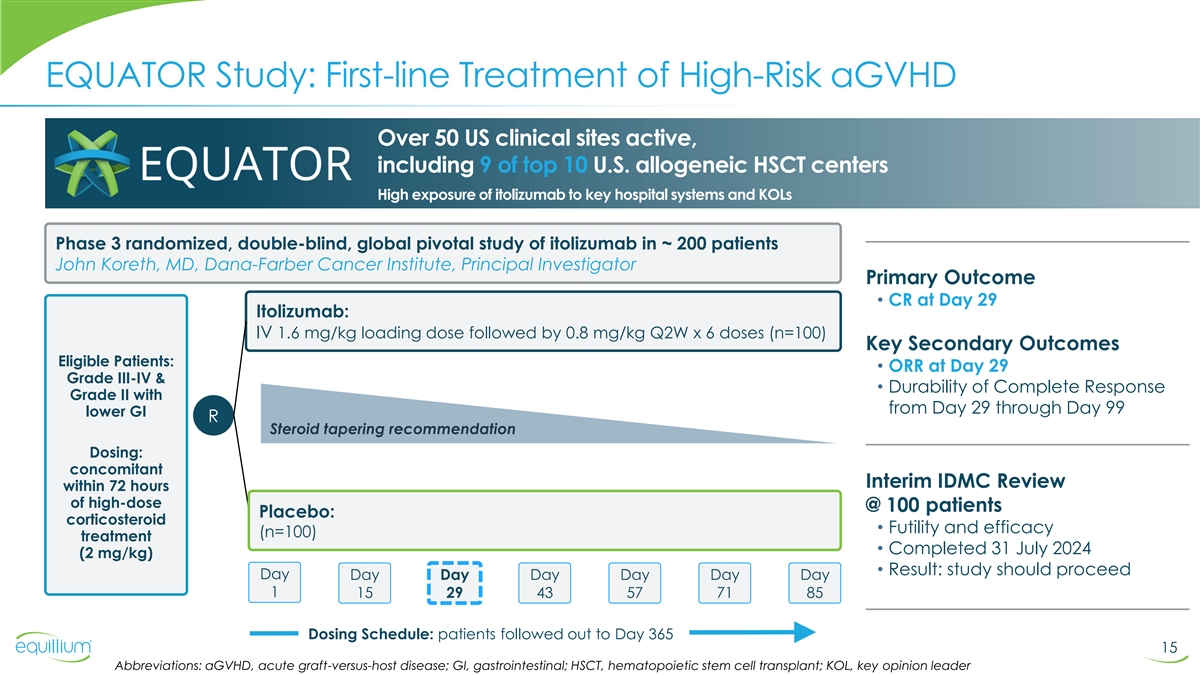
EQUATOR Study: First-line Treatment of High-Risk aGVHD Over 50 US clinical sites active, including 9 of top 10 U.S. allogeneic HSCT centers High exposure of itolizumab to key hospital systems and KOLs Phase 3 randomized, double-blind, global pivotal study of itolizumab in ~ 200 patients John Koreth, MD, Dana-Farber Cancer Institute, Principal Investigator Primary Outcome • CR at Day 29 Itolizumab: IV 1.6 mg/kg loading dose followed by 0.8 mg/kg Q2W x 6 doses (n=100) Key Secondary Outcomes Eligible Patients: • ORR at Day 29 Grade III-IV & • Durability of Complete Response Grade II with from Day 29 through Day 99 lower GI R Steroid tapering recommendation Dosing: concomitant Interim IDMC Review within 72 hours of high-dose @ 100 patients Placebo: corticosteroid • Futility and efficacy (n=100) treatment • Completed 31 July 2024 (2 mg/kg) • Result: study should proceed Day Day Day Day Day Day Day 1 15 29 43 57 71 85 Dosing Schedule: patients followed out to Day 365 15 Abbreviations: aGVHD, acute graft-versus-host disease; GI, gastrointestinal; HSCT, hematopoietic stem cell transplant; KOL, key opinion leader
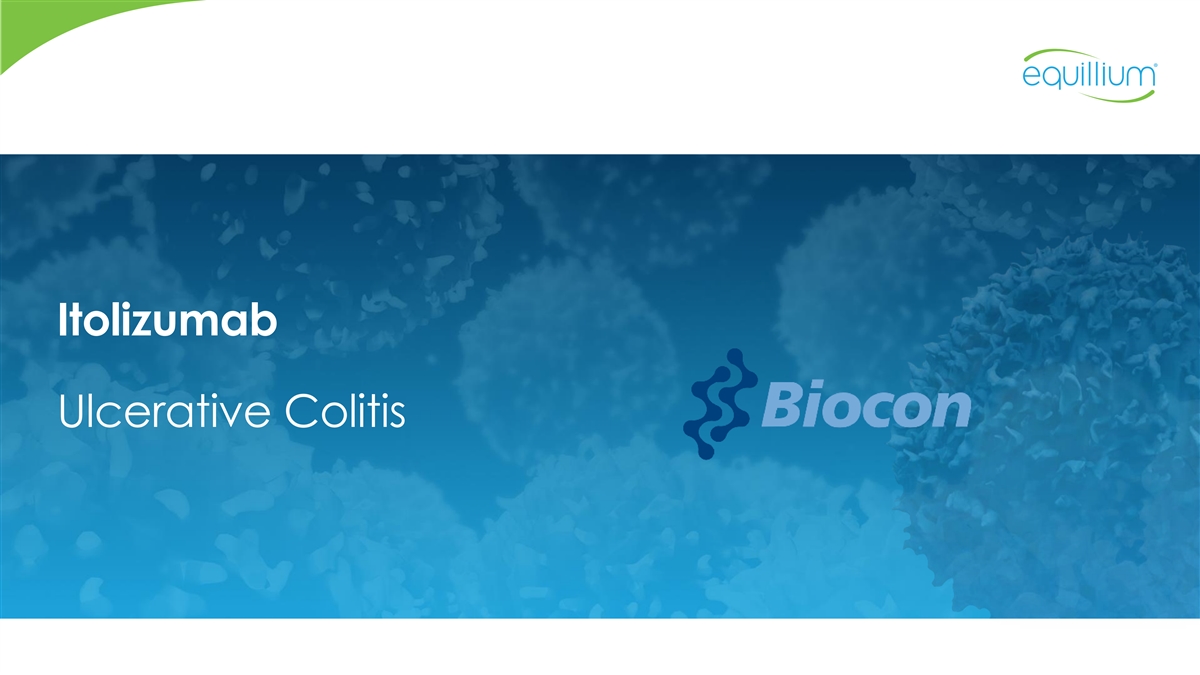
Itolizumab Ulcerative Colitis
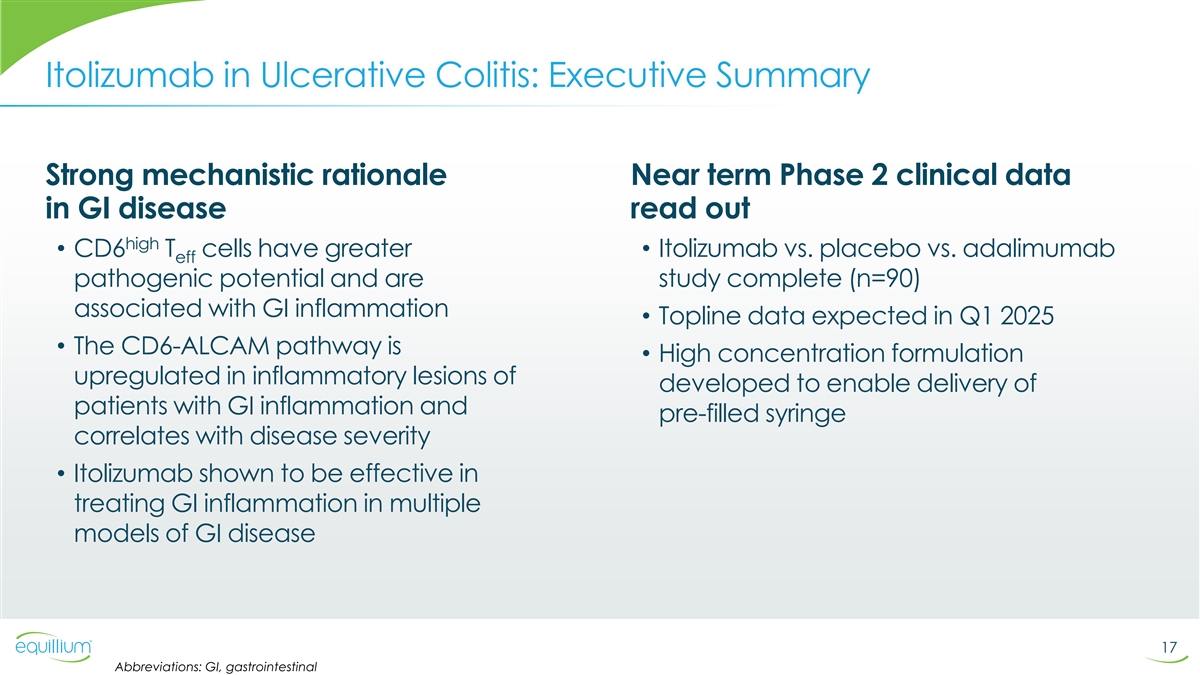
Itolizumab in Ulcerative Colitis: Executive Summary Strong mechanistic rationale Near term Phase 2 clinical data in GI disease read out high • CD6 T cells have greater • Itolizumab vs. placebo vs. adalimumab eff pathogenic potential and are study complete (n=90) associated with GI inflammation • Topline data expected in Q1 2025 • The CD6-ALCAM pathway is • High concentration formulation upregulated in inflammatory lesions of developed to enable delivery of patients with GI inflammation and pre-filled syringe correlates with disease severity • Itolizumab shown to be effective in treating GI inflammation in multiple models of GI disease 17 Abbreviations: GI, gastrointestinal
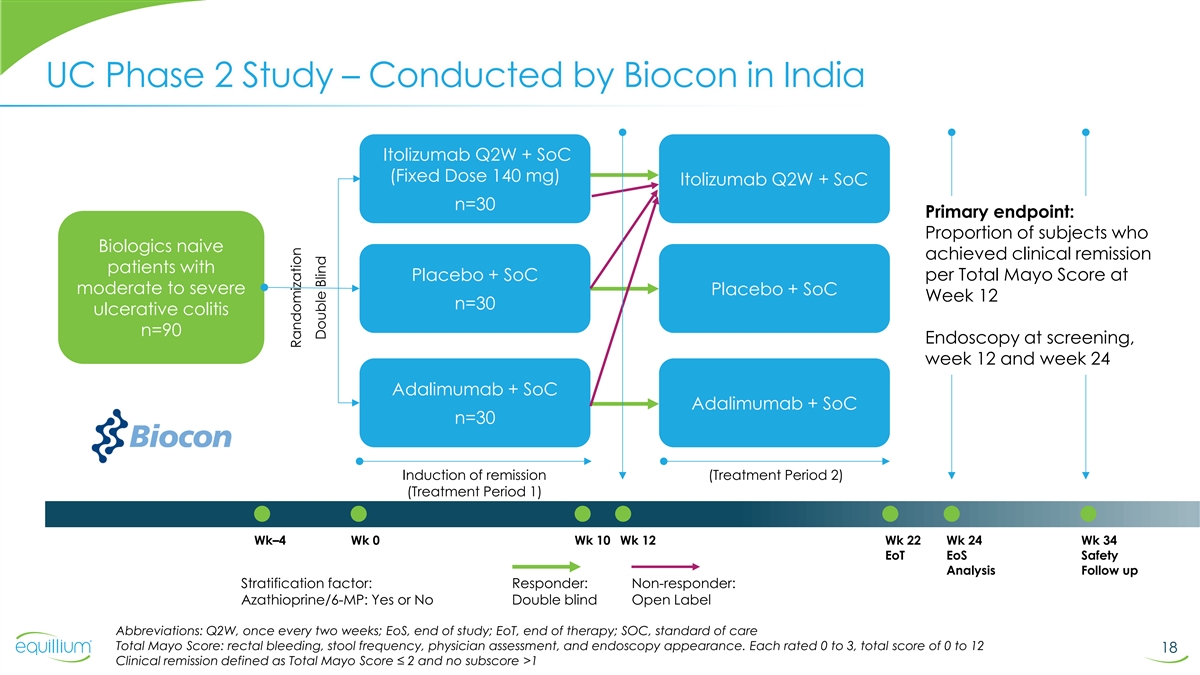
UC Phase 2 Study – Conducted by Biocon in India Itolizumab Q2W + SoC + SoC (Fixed Dose 140 mg) ltolizumab Q2W + SoC N=3 n=30 Primary endpoint: Proportion of subjects who Biologics naive achieved clinical remission patients with Placebo + SoC per Total Mayo Score at moderate to severe Placebo + SoC Week 12 n=30 ulcerative colitis n=90 Endoscopy at screening, week 12 and week 24 Adalimumab + SoC Adalimumab + SoC n=30 Induction of remission (Treatment Period 2) (Treatment Period 1) Wk–4 Wk 0 Wk 10 Wk 12 Wk 22 Wk 24 Wk 34 EoT EoS Safety Analysis Follow up Stratification factor: Responder: Non-responder: Azathioprine/6-MP: Yes or No Double blind Open Label Abbreviations: Q2W, once every two weeks; EoS, end of study; EoT, end of therapy; SOC, standard of care Total Mayo Score: rectal bleeding, stool frequency, physician assessment, and endoscopy appearance. Each rated 0 to 3, total score of 0 to 12 18 Clinical remission defined as Total Mayo Score ≤ 2 and no subscore >1 Randomization Double Blind
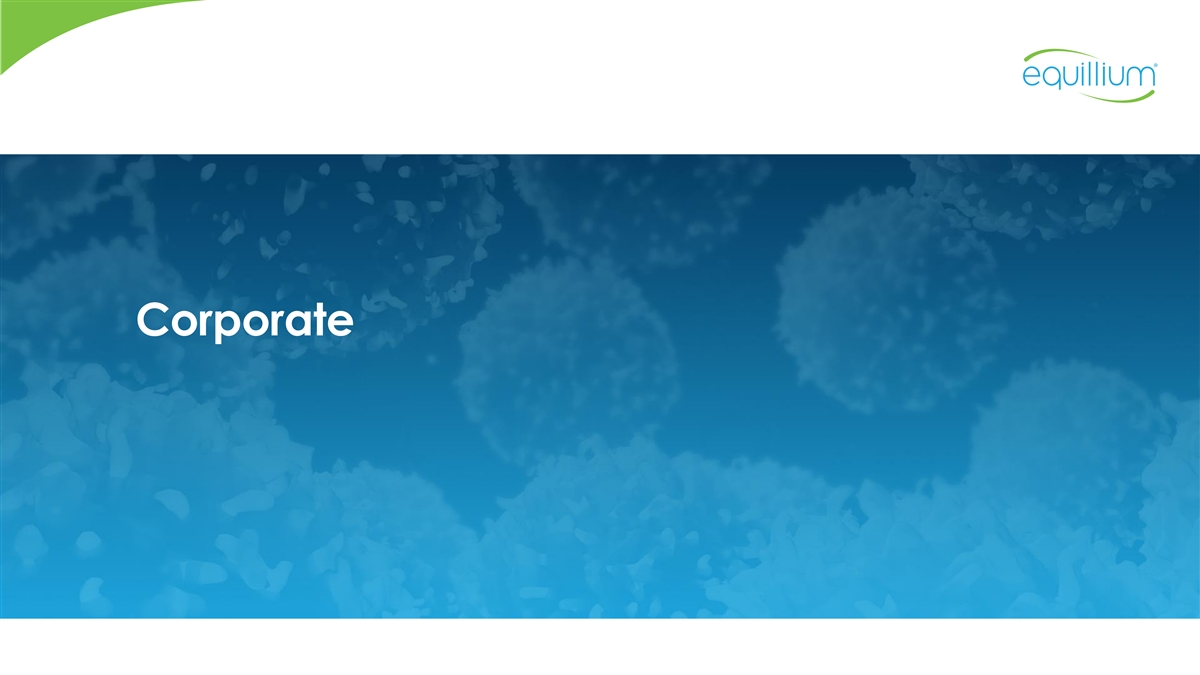
Corporate 19

Itolizumab Intellectual Property & Regulatory Exclusivity Biologics Exclusivity 12 years Itolizumab Compositions / Methods 12 patent families Formulations 27 issued patents 34 applications pending Method of Treating MS and IBD (as of October 2024) Method of Inhibiting CD6 Method of Treating Lupus Method of Treating Severe Asthma Lupus sCD6/sALCAM Diagnostic T-Cell Modulation Methods Method of Treating Coronavirus/COVID-19 Method of Treating Organ Damage Resulting from Invasive Surgery Biocon Filings EQ Filings 2014 2018 2022 2026 2030 2034 2038 2042 2044 2006 2010 Assumptions: • Listed applications will issue 20 • Biologics Exclusivity will be granted and will begin at NDA approval Itolizumab filings under exclusive license to Equillium for US, CA, AU, NZ • Potential patent term extensions not shown
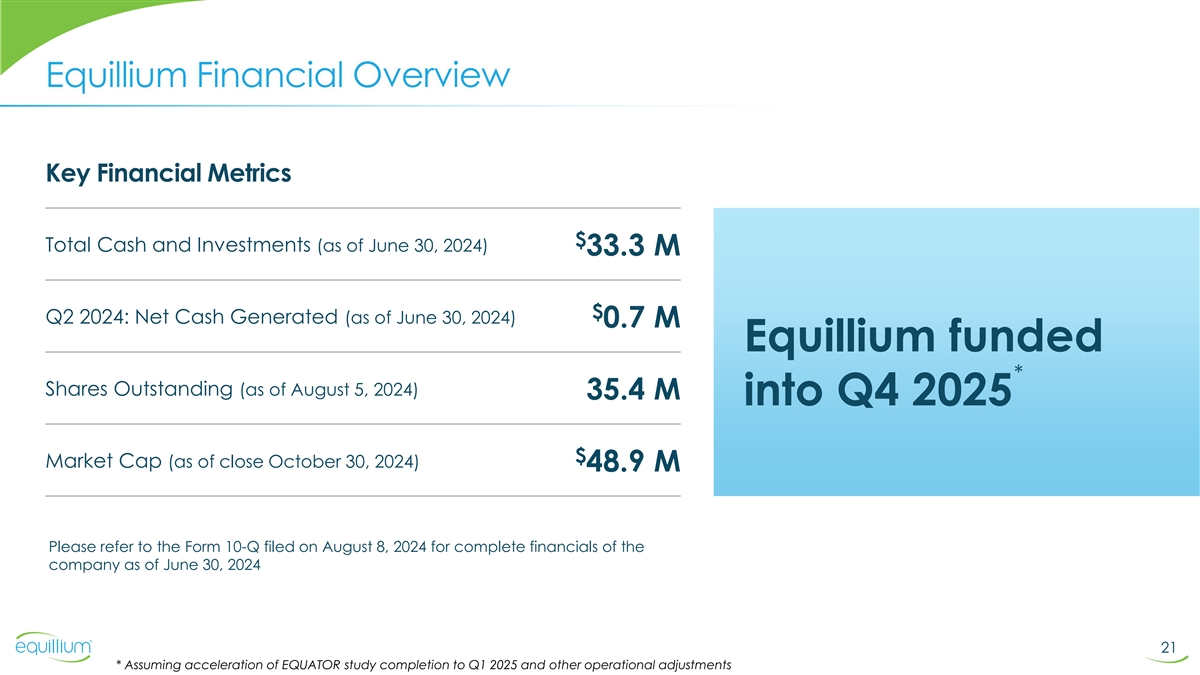
Equillium Financial Overview Key Financial Metrics $ Total Cash and Investments (as of June 30, 2024) 33.3 M $ Q2 2024: Net Cash Generated (as of June 30, 2024) 0.7 M Equillium funded * Shares Outstanding (as of August 5, 2024) 35.4 M into Q4 2025 $ Market Cap (as of close October 30, 2024) 48.9 M Please refer to the Form 10-Q filed on August 8, 2024 for complete financials of the company as of June 30, 2024 21 * Assuming acceleration of EQUATOR study completion to Q1 2025 and other operational adjustments

Equillium Summary Anticipated Major Milestones Itolizumab Derisked • Phase 3 aGVHD topline data – potential to • EQUATOR Phase 3 interim safety and efficacy review July 2024: accelerate to Q1 2025 (modified study) IDMC recommended study to proceed as planned • Phase 2 Ulcerative Colitis data expected Q1 2025• Positive topline LN data reported • Commercial-scale manufacturing in place w/ Biocon Commercial Rights to Itolizumab Attractive Market Opportunity • Full commercial rights to all indications• No drugs approved in 1L aGVHD • EQ Territories: US, Canada, Australia & New Zealand • Approved GVHD drugs approaching $1B in US sales ® • JAKAFI 2L aGVHD /cGVHD (Incyte) ® • REZUROCK 2L cGVHD (Sanofi) • Ability to market independently with small commercial team 22 Abbreviations: aGVHD, acute graft-versus-host disease; cGVHD, chronic graft-versus-host disease; IDMC, independent data monitoring committee; LN, lupus nephritis; 1L, first-line; 2L, second-line
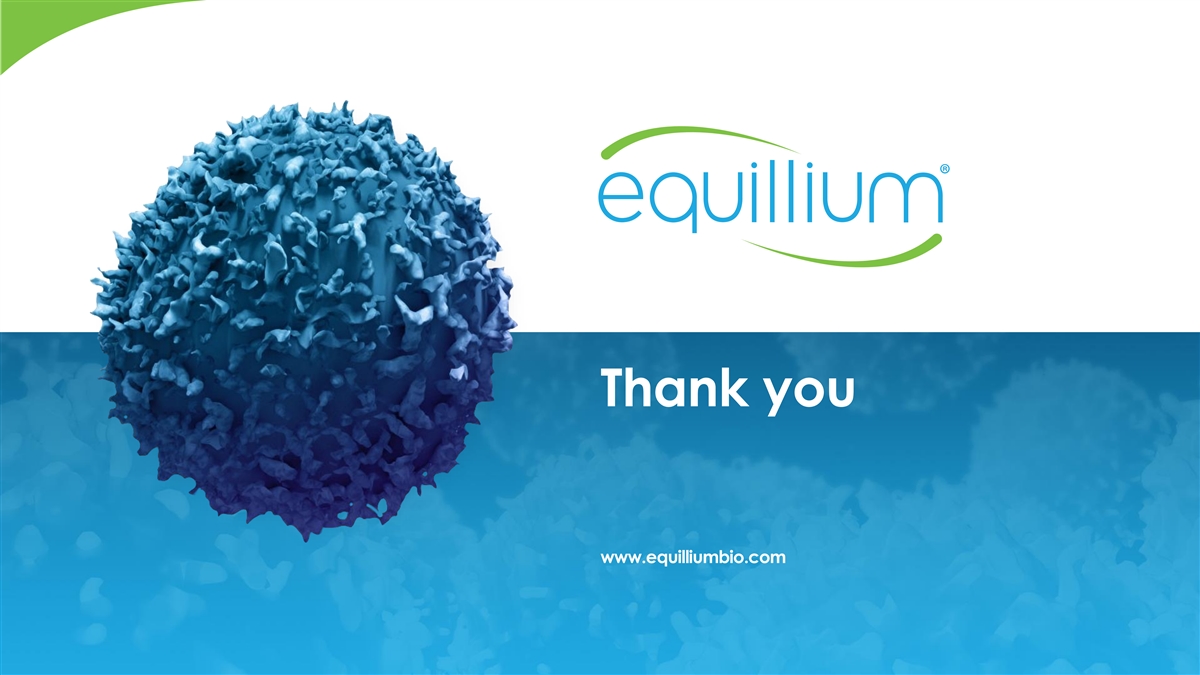
Thank you www.equilliumbio.com 23






















